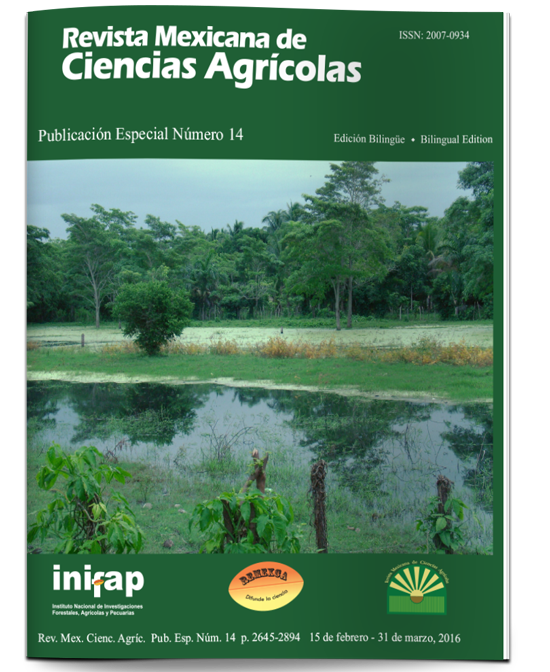El uso de componentes principales en la clasificación melisopalinológica de la miel de Apis mellifera L.
DOI:
https://doi.org/10.29312/remexca.v0i14.454Keywords:
ACP, miel, melisopalinológia, Prinqual, TabascoAbstract
Se colectaron 38 muestras de miel de Apis mellifera L. en seis municipios, pertenecientes a las cinco subregiones del estado de Tabasco, se realizó el análisis melisopalinologico obteniendo 37 tipos polínicos de importancia (>10%). Bursera simaruba L. (Burseraceae), Spondiasmombin (Anacardiaceae), Diphysa sp. (Fabaceae), Erythrina sp., (Fabaceae), Mimosa orthocarpa (Fabaceae), Pipersp1, sp2, sp3 (Piperaceae), Machaerium sp., (Fabaceae), Cecropia obtussifolia (Moraceae), Psidium guajava (Myrtaceae), Acalypha sp., (Euphorbiaceae), Celtis sp., (Ulmaceae), Heliocarpus appendiculatus (Tiliaceae), Conocarpus sp., (Combretaceae), Haematoxy lumcampechianum (Fabaceae), Mimosa albida (Fabaceae), Zea mays L. (Gramineae), Diphysacarthagenensis (Fabaceae), Quercus sp., (Fagaceae), Citrus sp., (Rutaceae), Cocos nucifera (Arecaceae), Mimosa sp., (Fabaceae), Mimosa pigra var. Berlandieri (Fabaceae), Eleocharis sp., (Cyperaceae), Rumex sp., (Polygonaceae), Eragrostis sp., (Poaceae), Spondiasradlkoferi (Anacardiaceae), Muntingiacalabura (Elaeocarpaceae), Asteraceae sp1, (Asteraceae), Borreriaverticillata (Rubiaceae), Coccolobaaff. Diversifolia (Polygonaceae), Quercusoleoides (Fagaceae). En general se clasificaron 22 muestras de miel multifloral, 9 monof loral y 7 bif loral. Y al realizar el ACP, se obtuvieron dos componentes que explican 65% de la variación total, mostrando que Cárdenas y Huimanguillo tienen afinidad por Bursera simaruba L. (Burseraceae) y Cecropiaobtussifolia (Moraceae), en cambio Centro, Tacotalpa y Balancán comparten preferencia por Mimosa albida (Fabaceae), Psidiumguajava (Myrtaceae) y Rumex sp. (Polygonaceae) y Centla en cambio mostró una clara diferencia con los 5 municipios restantes.
Downloads
Downloads
Published
How to Cite
Issue
Section
License
The authors who publish in Revista Mexicana de Ciencias Agrícolas accept the following conditions:
In accordance with copyright laws, Revista Mexicana de Ciencias Agrícolas recognizes and respects the authors’ moral right and ownership of property rights which will be transferred to the journal for dissemination in open access. Invariably, all the authors have to sign a letter of transfer of property rights and of originality of the article to Instituto Nacional de Investigaciones Forestales, Agrícolas y Pecuarias (INIFAP) [National Institute of Forestry, Agricultural and Livestock Research]. The author(s) must pay a fee for the reception of articles before proceeding to editorial review.
All the texts published by Revista Mexicana de Ciencias Agrícolas —with no exception— are distributed under a Creative Commons License Attribution-NonCommercial 4.0 International (CC BY-NC 4.0), which allows third parties to use the publication as long as the work’s authorship and its first publication in this journal are mentioned.
The author(s) can enter into independent and additional contractual agreements for the nonexclusive distribution of the version of the article published in Revista Mexicana de Ciencias Agrícolas (for example include it into an institutional repository or publish it in a book) as long as it is clearly and explicitly indicated that the work was published for the first time in Revista Mexicana de Ciencias Agrícolas.
For all the above, the authors shall send the Letter-transfer of Property Rights for the first publication duly filled in and signed by the author(s). This form must be sent as a PDF file to: revista_atm@yahoo.com.mx; cienciasagricola@inifap.gob.mx; remexca2017@gmail.
This work is licensed under a Creative Commons Attribution-Noncommercial 4.0 International license.



